Search results for: 'Head'
-
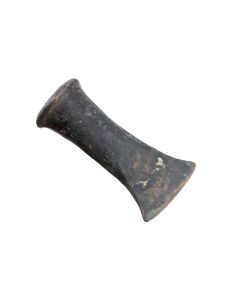 Bronze axe head with beautiful patina
Bronze axe head with beautiful patinaKörper mit ovalem Querschnitt und charakteristischer Öffnung am Nacken, für die einfache Schäftung des Beilkopfes. Dieses Exemplar besticht besonders durch seine edle Patina, einem Zeugnis der vergangenen Jahrhunderte.
Price: on request Bronze axe head with beautiful patina
Bronze axe head with beautiful patinaKörper mit ovalem Querschnitt und charakteristischer Öffnung am Nacken, für die einfache Schäftung des Beilkopfes. Derartige Beile wurden in der späten Bronzezeit als Arbeitsgeräte vielfältig eingesetzt. Spannendes Belegstück.
Price: on request Socketed axe head with colourful patina
Socketed axe head with colourful patinaKörper mit ovalem Querschnitt und charakteristischer Öffnung am Nacken, für die einfache Schäftung des Beilkopfes. Derartige Beile wurden in der späten Bronzezeit als Arbeitsgeräte vielfältig eingesetzt. Spannendes Belegstück.
Price: on request Late Bronze age socketed axe head
Late Bronze age socketed axe headKörper mit ovalem Querschnitt und charakteristischer Öffnung am Nacken, für die einfache Schäftung des Beilkopfes. Derartige Beile wurden in der späten Bronzezeit als Arbeitsgeräte vielfältig eingesetzt. Spannendes Belegstück.
Price: on request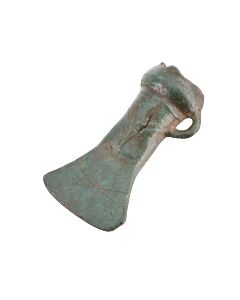 Socketed axe head with beautiful patina
Socketed axe head with beautiful patinaKörper mit ovalem Querschnitt und charakteristischer Öffnung am Nacken, für die einfache Schäftung des Beilkopfes. Dieses Exemplar besticht besonders durch seine schöne Patina, einem Zeugnis der vergangenen Jahrhunderte.
Price: on request Late Bronze age socketed axe head
Late Bronze age socketed axe headElegant geformter Beilkopf aus der späten Bronzezeit Europas. Es gehört zu den Tüllenbeilen. Dessen großer Vorzug besteht gegenüber früheren Beiltypen in der einfachen Schäftung mittels der Öffnung am Nacken.
Price: on request Small axe head from the New Stone Age
Small axe head from the New Stone AgeCompact stone axe from the 3rd Millenium BC. Found on the Danish island of Moen.
Price: on request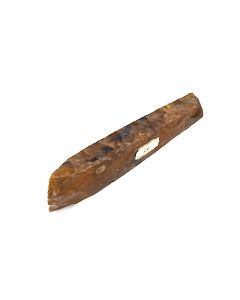 Neolithic axe head from Luetzow in Northern Germany
Neolithic axe head from Luetzow in Northern GermanyNice polished axe from brown flint. It was found more than 100 years ago near the town of Luetzow.
Price: on request Neolithic axe head from Luetzow in Northern Germany
Neolithic axe head from Luetzow in Northern GermanyPolished axe made of beautiful brown flint. It was found more than 100 years ago near the town of Luetzow.
Price: on request Decorated socketed axe head with beautiful patina
Decorated socketed axe head with beautiful patinaBeilkopf aus der späten Bronzezeit Europas. Der Vorzug der Tüllenbeile gegenüber früheren Beiltypen besteht in der einfachen Schäftung mittels der Öffnung am Nacken. Museumswürdige dunkle Patina.
Price: on request Socketed axe head of the Urnfield period
Socketed axe head of the Urnfield periodBronzebeilkopf mit vierkantigem Querschnitt, seltener Typ. Schön erkennbarer Grat von der Herstellung in einer Gussform. Ringöse an der Seite. Späte Bronzezeit.
Price: on request Rare massive Bronze Age socketed axe head
Rare massive Bronze Age socketed axe headDieses Tüllenbeil ist durch seine Kompaktheit eine seltene Variante, die einen besonders massiven Eindruck macht und damit für den kraftvollen Arbeitseinsatz geeignet sein dürfte. Interessantes Exemplar aus der späten Bronzezeit Europas.
Price: on request Bronze socketed axe head from large collection
Bronze socketed axe head from large collectionSehr schönes Exemplar eines Bronzebeils vom Typ der sogenannten Tüllenbeile. Es stammt aus einer gut geführten Sammlung, die einen breiten Querschnitt europäischer Tüllenbeile abbildet.
Price: on request Massive Bronze Age spear head, possibly celtic
Massive Bronze Age spear head, possibly celticPerfectly preserved, large piece with beautiful patina. From an old German collection.
Price: on request Roman iron spear head from the Rhineland
Roman iron spear head from the RhinelandFound near the Roman city of Novaesium, today's Neuss in Germany, an early Roman foundation and with this one of the oldest cities in Germany.
Price: on request Roman iron pilum (javelin) head from the Rhineland
Roman iron pilum (javelin) head from the RhinelandFound near the Roman city of Novaesium, today's Neuss in Germany, an early Roman foundation and with this one of the oldest cities in Germany.
Price: on request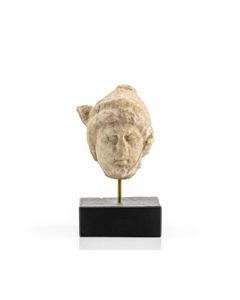 Hellenistic or Roman female marble head - possibly Athena
Hellenistic or Roman female marble head - possibly AthenaFrom the Austrian collection of Prof. Ritschel, carrier of the Large Cross of Honor of the Austrian Republic and many other prizes and honors.
€1,270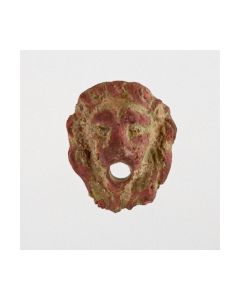 Roman bronze mount shaped as a lion's head
Roman bronze mount shaped as a lion's headFound in Dunham on Trent, Nottinghamshire, Great Britain on 8th of November 2013
€150 Thin butted axe head with finely polished surface
Thin butted axe head with finely polished surfaceDünnnackige Beilklinge der Trichterbecherkultur, Dolmenzeit bis Ganggrabzeit. Aus feinem, grauen Flint mit schönen Einschlüssen gearbeitet.
Price: on request Elegantly shaped socketed axe head with flat body
Elegantly shaped socketed axe head with flat bodyBronzenes Beil mit charakteristischer Öffnung am Nacken, für die einfache Schäftung des Beilkopfes. Derartige Beile wurden in der späten Bronzezeit als Arbeitsgeräte vielfältig eingesetzt. Eine Besonderheit ist der flache Körper.
Price: on request Thick butted axe head made of beautiful flint
Thick butted axe head made of beautiful flintKlinge eines dünnblattigen Dicknackenbeils. Trapezförmiger Körper aus schönem Feuerstein in charakteristischem Braun. Ganggrabzeit bis Dolchzeit.
Price: on request Neolithic axe head from the Corded Ware culture
Neolithic axe head from the Corded Ware cultureDicknackiger Beilkopf aus Feuerstein. Variante des Kregme-Typs. Einzelgrabkultur oder evt. Anfang der Dolchzeit, 2800 v. Chr. bis 1800 v. Chr.
Price: on request Thin butted axe head made of fine grey flint
Thin butted axe head made of fine grey flintDünnnackige Beilklinge der Trichterbecherkultur, Dolmenzeit bis Ganggrabzeit. Aus wunderbarem grauen Flint mit feiner Politur.
Price: on request Small socketed axe head from the late Bronze Age
Small socketed axe head from the late Bronze AgeBronzezeitlicher Beilkopf mit vierkantigem Querschnitt. Schön erkennbarer Grat von der Herstellung in einer Gussform. Ringöse an der Seite. Späte Bronzezeit.
Price: on request Thin butted axe head from the Funnel Beaker culture
Thin butted axe head from the Funnel Beaker cultureDünnnackige Beilklinge aus grauem Flint mit schönen rot-braunen Einschlüssen. Dolmenzeit bis Ganggrabzeit. Beeindruckend durch die Größe.
Price: on request Thin butted axe head from the Funnel Beaker culture
Thin butted axe head from the Funnel Beaker cultureHellgrauer bis dunkelgrauer Flint. Massiver Beilkopf, der durch Größe und Gewicht beeindruckt. Dolmenzeit bis Ganggrabzeit, 3900 bis 3000 v. Chr.
Price: on request Iron spear head worth the exhibition in a museum
Iron spear head worth the exhibition in a museumVery nice patina, smooth surface, rare degree of preservation for an iron object.
Price: on request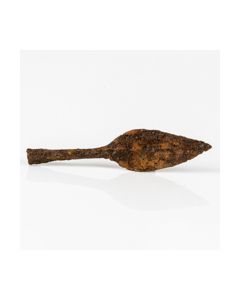 Celtic spear head - found in 1970s near Warminster, UK
Celtic spear head - found in 1970s near Warminster, UKMade of iron, about 1st century BC - 1st century AD. With export permit by the Arts Council of England.
Price: on request Celtic spear head - found in 1970s near Radstock, UK
Celtic spear head - found in 1970s near Radstock, UKIron, about 2nd century BC - 1st century AD. With export permit by the Arts Council of England.
Price: on request Celtic spear head - found 1982 near Frome, Sommerset, UK
Celtic spear head - found 1982 near Frome, Sommerset, UKIron, about 2nd century BC - 1st century AD. With export permit by the Arts Council of England.
Price: on request Roman headstud brooch
Roman headstud broochInteresting fibula with a covered hinge mechanism and enamel decoration on the bow. From the 2nd century Roman Britain. Published in two stardard works on ancient brooches by Richard Hattatt.
Price: on request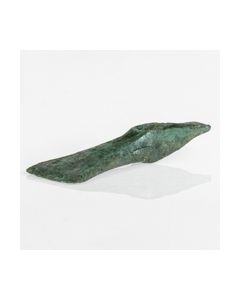 Palstave axehead with decoration
Palstave axehead with decorationExtremely well preserved piece from a Bronze Age hoard found in Manston, UK. 1400 to 1150 BC.
Price: on request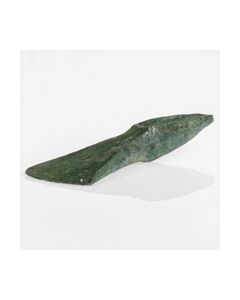 Palstave axehead with decoration
Palstave axehead with decorationExtremely well preserved piece from a Bronze Age hoard found in Manston, UK. 1400 to 1150 BC.
Price: on request Palstave axehead with triangle decoration
Palstave axehead with triangle decorationExtremely well preserved piece from a Bronze Age hoard found in Manston, UK. 1400 to 1150 BC. This axe belongs to a very rare type.
Price: on request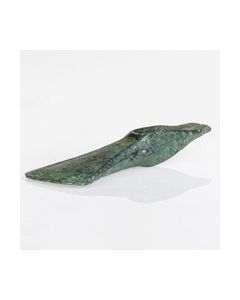 Palstave axehead with decoration
Palstave axehead with decorationExtremely well preserved piece from a Bronze Age hoard found in Manston, UK. 1400 to 1150 BC.
Price: on request Palstave axehead with decoration
Palstave axehead with decorationExtremely well preserved piece from a Bronze Age hoard found in Manston, UK. 1400 to 1150 BC.
Price: on request

